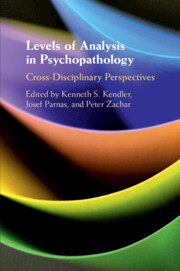Book contents
- Levels of Analysis in Psychopathology
- Advance Praise for Levels of Analysis in Psychopathology
- Levels of Analysis in Psychopathology
- Copyright page
- Contents
- Figures
- Tables
- Contributors
- Preface
- General Introduction
- Part I Neuroscience, Mechanisms, and RDoC
- Part II Phenomenology, Biological Psychology, and the Mind–Body Problem
- Part III Taxonomy, Integration, and Multiple Levels of Explanation
- Section 8
- Section 9
- Section 10
- Section 11
- Section 12
- Section 13
- Section 14
- Section 15
- 43 Introduction
- 44 Entity Focus: Applied Genetic Science at Different Levels
- 45 Commentary on “Entity Focus: Applied Genetic Science at Different Levels” by Eric Turkheimer
- Index
- References
44 - Entity Focus: Applied Genetic Science at Different Levels
from Section 15
Published online by Cambridge University Press: 02 April 2020
- Levels of Analysis in Psychopathology
- Advance Praise for Levels of Analysis in Psychopathology
- Levels of Analysis in Psychopathology
- Copyright page
- Contents
- Figures
- Tables
- Contributors
- Preface
- General Introduction
- Part I Neuroscience, Mechanisms, and RDoC
- Part II Phenomenology, Biological Psychology, and the Mind–Body Problem
- Part III Taxonomy, Integration, and Multiple Levels of Explanation
- Section 8
- Section 9
- Section 10
- Section 11
- Section 12
- Section 13
- Section 14
- Section 15
- 43 Introduction
- 44 Entity Focus: Applied Genetic Science at Different Levels
- 45 Commentary on “Entity Focus: Applied Genetic Science at Different Levels” by Eric Turkheimer
- Index
- References
Summary
Psychopathologists have been arguing forever about whether psychiatric syndromes are some variety of “biological,” “genetic,” or “brain disorders.”This argument has been hobbled by the lack of a coherent theory of what it means for a complex behavioral entity to be biological, or what the alternative to being biological might be. In the absence of a well-articulated theory, there has been a tendency to assume that the question at issue is whether or not behavioral entities are correlated with chemical, neurological, or genetic variables; and since the answer to this question is always affirmative, the consensus has generally been to move psychiatric syndromes farther and farther down the hierarchy of the sciences. I make the case that questions of whether complex behavioral categories correlate with physical ones is misplaced. Instead, I suggest that questions about the proper location of entities involve determining the level at which the entity is most clearly defined; at other levels the entity is out of focus: detectible but blurry. Blurry entities are poor candidates for successful scientific analysis.
- Type
- Chapter
- Information
- Levels of Analysis in PsychopathologyCross-Disciplinary Perspectives, pp. 521 - 544Publisher: Cambridge University PressPrint publication year: 2020
References
- 3
- Cited by

